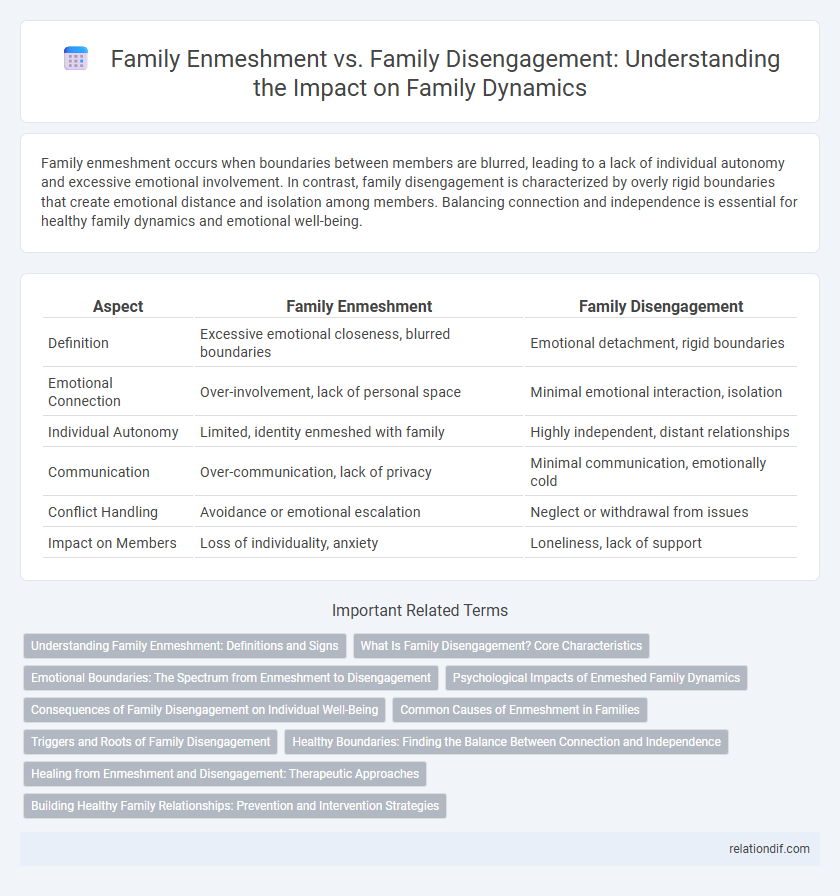Family enmeshment occurs when boundaries between members are blurred, leading to a lack of individual autonomy and excessive emotional involvement. In contrast, family disengagement is characterized by overly rigid boundaries that create emotional distance and isolation among members. Balancing connection and independence is essential for healthy family dynamics and emotional well-being.
Table of Comparison
| Aspect | Family Enmeshment | Family Disengagement |
|---|---|---|
| Definition | Excessive emotional closeness, blurred boundaries | Emotional detachment, rigid boundaries |
| Emotional Connection | Over-involvement, lack of personal space | Minimal emotional interaction, isolation |
| Individual Autonomy | Limited, identity enmeshed with family | Highly independent, distant relationships |
| Communication | Over-communication, lack of privacy | Minimal communication, emotionally cold |
| Conflict Handling | Avoidance or emotional escalation | Neglect or withdrawal from issues |
| Impact on Members | Loss of individuality, anxiety | Loneliness, lack of support |
Understanding Family Enmeshment: Definitions and Signs
Family enmeshment occurs when boundaries between family members are blurred, leading to excessive emotional involvement and a lack of individual autonomy. Signs include over-dependence, difficulty maintaining personal privacy, and feelings of guilt or anxiety when asserting independence. Recognizing enmeshment is crucial for fostering healthy relationships where both connection and individuality are respected.
What Is Family Disengagement? Core Characteristics
Family disengagement refers to emotional and physical distance among family members, where communication is minimal and support is lacking. Core characteristics include limited interaction, weak emotional bonds, and a lack of involvement in each other's lives, often resulting in feelings of isolation or neglect. This dynamic contrasts with enmeshment by promoting autonomy but risking disconnection and unresolved conflicts.
Emotional Boundaries: The Spectrum from Enmeshment to Disengagement
Emotional boundaries in families range from enmeshment, where members experience blurred personal limits leading to over-identification and loss of autonomy, to disengagement, characterized by emotional distance and lack of support. Enmeshed families often struggle with codependency and difficulty managing individual emotions, while disengaged families face challenges in providing warmth and connection. Balancing emotional boundaries fosters healthier relationships by promoting autonomy alongside emotional closeness.
Psychological Impacts of Enmeshed Family Dynamics
Enmeshed family dynamics often lead to blurred boundaries, resulting in heightened anxiety and identity confusion among members. Psychological impacts include difficulty in developing autonomy, increased dependency, and challenges in establishing healthy interpersonal relationships. This environment can foster emotional entanglement that impedes individual growth and contributes to long-term mental health issues such as depression and low self-esteem.
Consequences of Family Disengagement on Individual Well-Being
Family disengagement often results in emotional isolation, leading to increased feelings of loneliness and depression in individuals. The lack of supportive family connections can impair the development of healthy coping mechanisms and reduce overall psychological resilience. This detachment may also contribute to poor communication skills and difficulties in forming intimate relationships outside the family unit.
Common Causes of Enmeshment in Families
Common causes of family enmeshment include overly dependent relationships where individual boundaries become blurred due to excessive emotional involvement. Parental overprotection and lack of autonomy often contribute to enmeshment, leading family members to prioritize collective needs over personal growth. This dynamic can also stem from unresolved family trauma or dysfunctional communication patterns that inhibit independence.
Triggers and Roots of Family Disengagement
Family disengagement often stems from unresolved conflicts, communication breakdowns, and emotional neglect that create physical or emotional distance among members. Triggers include prolonged stress, lack of support, significant life changes, and unmet emotional needs, which increase feelings of isolation. Root causes of disengagement typically involve past trauma, inconsistent parenting, and boundary violations leading to diminished trust and connection.
Healthy Boundaries: Finding the Balance Between Connection and Independence
Healthy family dynamics require balancing connection and independence by setting clear boundaries that respect individual autonomy while fostering emotional support. Family enmeshment occurs when boundaries are blurred, leading to over-involvement and loss of personal identity, whereas family disengagement involves overly rigid boundaries resulting in emotional distance and isolation. Establishing healthy boundaries promotes mutual respect, effective communication, and secure relationships that support both closeness and individuality.
Healing from Enmeshment and Disengagement: Therapeutic Approaches
Healing from family enmeshment and disengagement often involves therapeutic approaches such as family systems therapy, which aims to restore boundaries and improve communication patterns. Cognitive-behavioral therapy (CBT) helps individuals identify and change dysfunctional beliefs rooted in these relational dynamics. Trauma-informed care focuses on addressing the emotional wounds caused by enmeshment or disengagement, fostering resilience and healthier family interactions.
Building Healthy Family Relationships: Prevention and Intervention Strategies
Building healthy family relationships requires recognizing the signs of family enmeshment, where boundaries are blurred, and family disengagement, characterized by emotional distance and lack of support. Effective prevention strategies include fostering clear communication, establishing appropriate boundaries, and encouraging individual autonomy while maintaining emotional connectedness. Intervention approaches often involve family therapy techniques that promote trust, mutual respect, and problem-solving skills to restore balance and improve relational dynamics.
Family Enmeshment vs Family Disengagement Infographic

 relationdif.com
relationdif.com